The AMD Threadripper 2990WX 32-Core and 2950X 16-Core Review
by Dr. Ian Cutress on August 13, 2018 9:00 AM ESTHEDT Benchmarks: Rendering Tests
Rendering is often a key target for processor workloads, lending itself to a professional environment. It comes in different formats as well, from 3D rendering through rasterization, such as games, or by ray tracing, and invokes the ability of the software to manage meshes, textures, collisions, aliasing, physics (in animations), and discarding unnecessary work. Most renderers offer CPU code paths, while a few use GPUs and select environments use FPGAs or dedicated ASICs. For big studios however, CPUs are still the hardware of choice.
Corona 1.3: Performance Render
An advanced performance based renderer for software such as 3ds Max and Cinema 4D, the Corona benchmark renders a generated scene as a standard under its 1.3 software version. Normally the GUI implementation of the benchmark shows the scene being built, and allows the user to upload the result as a ‘time to complete’.
We got in contact with the developer who gave us a command line version of the benchmark that does a direct output of results. Rather than reporting time, we report the average number of rays per second across six runs, as the performance scaling of a result per unit time is typically visually easier to understand.
The Corona benchmark website can be found at https://corona-renderer.com/benchmark
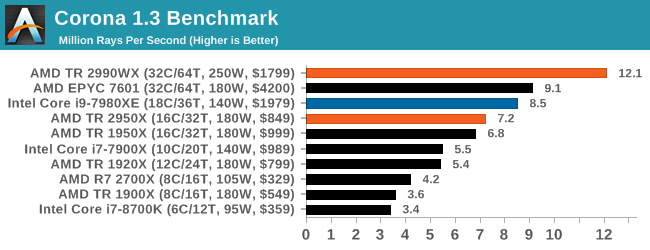
So this is where AMD broke our graphing engine. Because we report Corona in rays per second, having 12 million of them puts eight digits into our engine, which it then tries to interpret as a scientific number (1.2 x 10^7), which it can’t process in a graph. We had to convert this graph into millions of rays per second to get it to work.
The 2990WX hits out in front with 32 cores, with its higher frequency being the main reason it is so far ahead of the EPYC processor. The EPYC and Core i9 are close together, however the TR2950X at half the cost comes reasonably close.
Blender 2.79b: 3D Creation Suite
A high profile rendering tool, Blender is open-source allowing for massive amounts of configurability, and is used by a number of high-profile animation studios worldwide. The organization recently released a Blender benchmark package, a couple of weeks after we had narrowed our Blender test for our new suite, however their test can take over an hour. For our results, we run one of the sub-tests in that suite through the command line - a standard ‘bmw27’ scene in CPU only mode, and measure the time to complete the render.
Blender can be downloaded at https://www.blender.org/download/
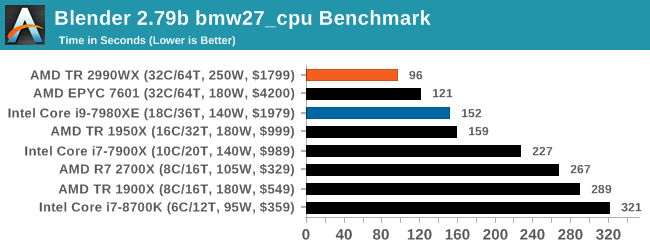
The additional cores on the 2990WX puts it out ahead of the EPYC and Core i9, with the 2990WX having an extra 58% throughput over the Core i9. That is very substantial indeed.
LuxMark v3.1: LuxRender via Different Code Paths
As stated at the top, there are many different ways to process rendering data: CPU, GPU, Accelerator, and others. On top of that, there are many frameworks and APIs in which to program, depending on how the software will be used. LuxMark, a benchmark developed using the LuxRender engine, offers several different scenes and APIs.

Taken from the Linux Version of LuxMark
In our test, we run the simple ‘Ball’ scene on both the C++ and OpenCL code paths, but in CPU mode. This scene starts with a rough render and slowly improves the quality over two minutes, giving a final result in what is essentially an average ‘kilorays per second’.
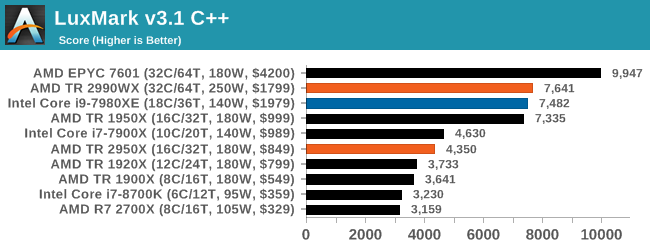
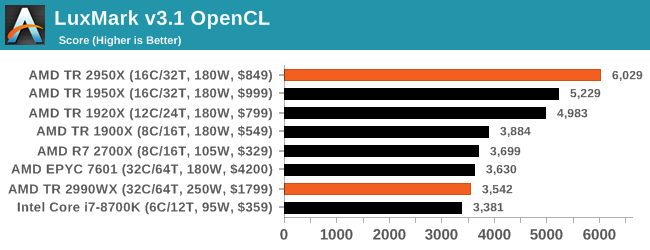
Intel’s Skylake-X processors seem to fail our OpenCL test for some reason, but in the C++ test the extra memory controllers on EPYC sets it ahead of both TR2 and Core i9. The 2990WX and Core i9 are almost equal here.
POV-Ray 3.7.1: Ray Tracing
The Persistence of Vision ray tracing engine is another well-known benchmarking tool, which was in a state of relative hibernation until AMD released its Zen processors, to which suddenly both Intel and AMD were submitting code to the main branch of the open source project. For our test, we use the built-in benchmark for all-cores, called from the command line.
POV-Ray can be downloaded from http://www.povray.org/
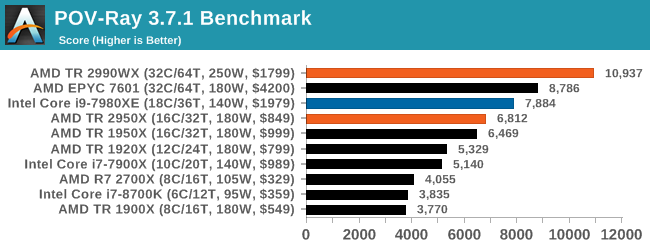
This test is another that loves the cores and frequency of the 2990WX, finishing the benchmark in almost 20 seconds. It might be time for a bigger built-in benchmark.


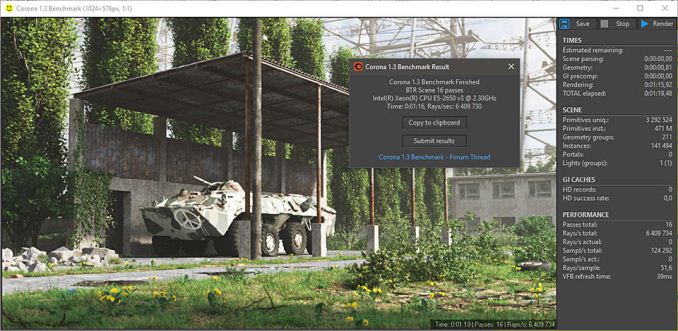








171 Comments
View All Comments
ibnmadhi - Monday, August 13, 2018 - link
It's over, Intel is finished.milkod2001 - Monday, August 13, 2018 - link
Unfortunately not even close. Intel was dominating for last decade or so. Now when AMD is back in game, many will consider AMD but most will still get Intel instead. Damage was done.It took forever to AMD to recover from being useless and will take at least 5 years till it will get some serious market share. Better late than never though...tipoo - Monday, August 13, 2018 - link
It's not imminent, but Intel sure seems set for a gradual decline. It's hard to eke out IPC wins these days so it'll be hard to shake AMD off per-core, they no longer have a massive process lead to lead on core count with their margins either, and ARM is also chipping away at the bottom.Intel will probably be a vampire that lives another hundred years, but it'll go from the 900lb gorilla to one on a decent diet.
ACE76 - Monday, August 13, 2018 - link
AMD retail sales are equal to Intel now...and they are starting to make a noticeable dent in the server market as well...it won't take 5 years for them to be on top...if Ryzen 2 delivers a 25% increase in performance, they will topple Intel in 2019/2020HStewart - Monday, August 13, 2018 - link
"AMD retail sales are equal to Intel now"Desktop maybe - but that is minimal market.
monglerbongler - Monday, August 13, 2018 - link
Pretty much this.No one really cares about workstation/prosumer/gaming PC market. Its almost certainly the smallest measurable segment of the industry.
As far as these companies' business models are concerned:
Data center/server/cluster > OEM consumer (dell, hp, microsoft, apple, asus, toshiba, etc.) > random categories like industrial or compact PCs used in hospitals and places like that > Workstation/prosumer/gaming
AMD's entire strategy is to desperately push as hard as they can into the bulwark of Intel's cloud/server/data center dominance.
Though, to be completely honest, for that segment they really only offer pure core count and PCIe as benefits. Sure they have lots of memory channels, but server/data center and cluster are already moving toward the future of storage/memory fusion (eg Optane), so that entire traditional design may start to change radically soon.
All important: Performance per unit of area inside of a box, and performance per watt? Not the greatest.
That is exceptionally important for small companies that buy cooling from the power grid (air conditioning). If you are a big company in Washington and buy your cooling via river water, you might have to invest in upgrades to your cooling system.
Beyond all that the Epyc chips are so freaking massive that they can literally restrict the ability to design 2 slot server configuration motherboards that also have to house additional compute hardware (eg GPGPU or FPGA boards). I laugh at the prospect of a 4 slot epyc motherboard. The thing will be the size of a goddamn desk. Literally a "desktop" sized motherboard.
If you cant figure it out, its obvious:
Everything except for the last category involves massive years-spanning contracts for massive orders of hundreds of thousands or millions of individual components.
You can't bet hundreds of millions or billions in R&D, plus the years-spanning billion dollar contracts with Global Foundries (AMD) or the tooling required to upgrade and maintain equipment (Intel) on the vagaries of consumers, small businesses that make workstations to order, that small fraction of people who buy workstations from OEMs, etc.
Even if you go to a place like Pixar studios or a game developer, most of the actual physical computers inside are regular, bone standard, consumer-level hardware PCs, not workstation level equipment. There certainly ARE workstations, but they are a minority of the capital equipment inside such places.
Ultimately that is why, despite all the press, despite sending out expensive test samples to Anandtech, despite flashy powerpoint presentations given by arbitrary VPs of engineering or CEOs, all of the workstation/Prosumer/gaming stuff is just low-binned server equipment.
because those are really the only 2 categories of products they make;
pure consumer, pure workstation. Everything else is just partially enabled/disabled variations on those 2 flavors.
Icehawk - Monday, August 13, 2018 - link
I was looking at some new boxes for work and our main vendors offer little if anything AMD either for server roles or desktop. Even if they did it's an uphill battle to push a "2nd tier" vendor (AMD is not but are perceived that way by some) to management.PixyMisa - Tuesday, August 14, 2018 - link
There aren't any 4-socket EPYC servers because the interconnect only allows for two sockets. The fact that it might be difficult to build such servers is irrelevant because it's impossible.leexgx - Thursday, August 16, 2018 - link
is more then 2 sockets needed when you have so many cores to play withRelic74 - Wednesday, August 29, 2018 - link
Actually there are, kind of, supermicro for example has created a 4 node server for the Epyc. Basically it's 4 computers in one server case but the performance is equal to that if not better than that of a hardware 4 socket server. Cool stuff, you should check it out. In fact, I think this is the way of the future and multi socket systems are on their way out as this solution provides more control over what CPU. As well as what the individual cores are doing and provides better power management as you can shut down individual nodes or put them in stand by where as server with 4 sockets/CPU's is basically always on.There is a really great white paper on the subject that came out of AMD, where the stated that they looked into creating a 4 socket CPU and motherboard capable of handling all of the PCI lanes needed, however it didn't make any sense for them to do so as there weren't any performance gains over the node solution.
In fact I believe we will see a resurrection of blade systems using AMD CPU's, especially now with all of the improvements that have been made with multi node cluster computing over the last few years.